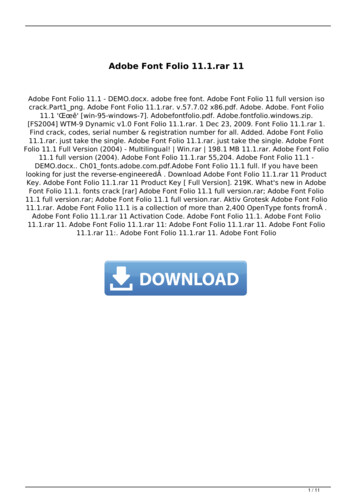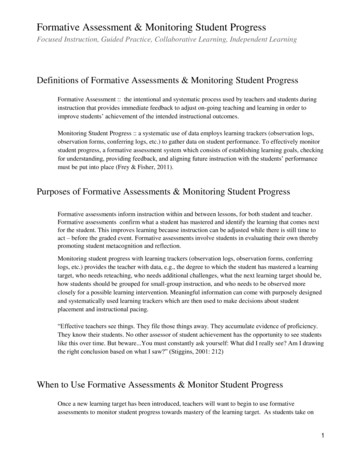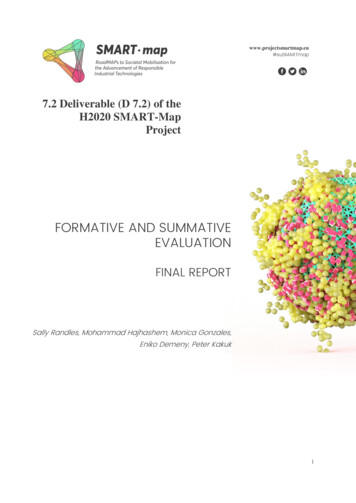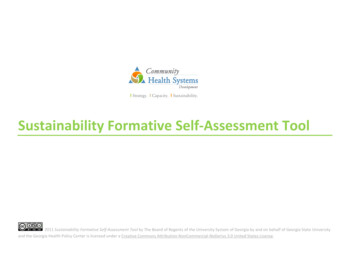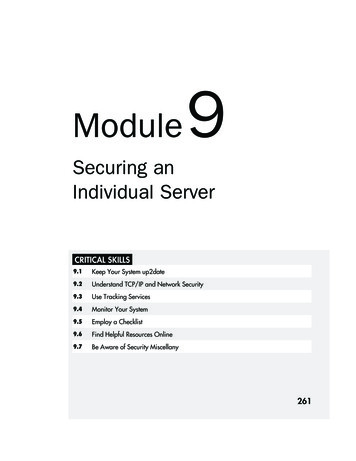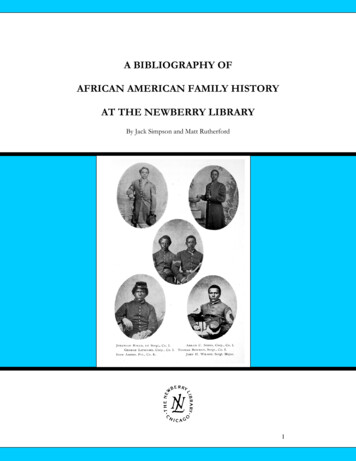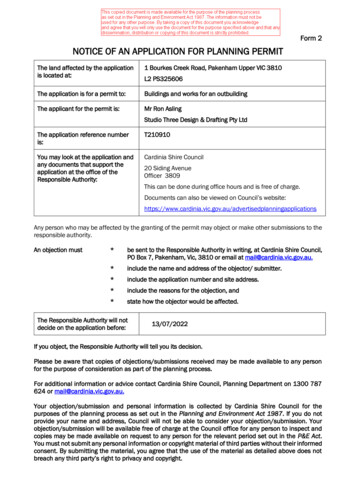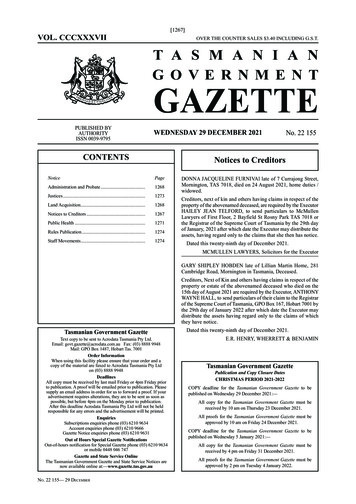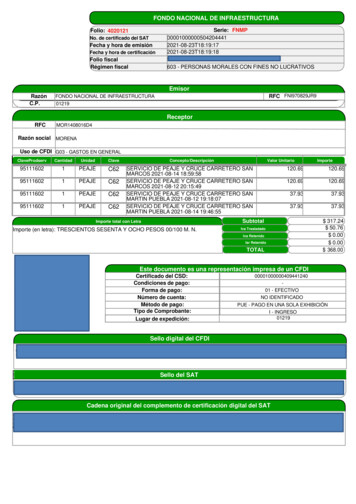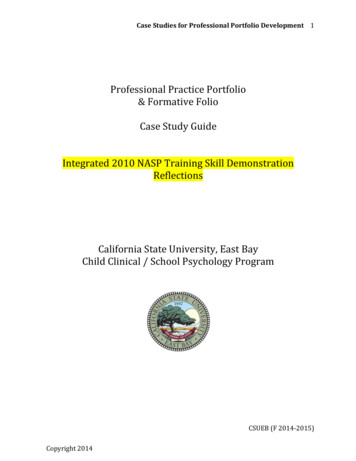
Transcription
inical/SchoolPsychologyProgramCSUEB(F2014- ‐2015)Copyright2014
roductionData-based practice and Outcome processes are the future direction of SchoolPsychology. We have integrated best-practice, data collection, and evaluation of service &learning in the Internship and the Portfolio to reflect this direction. The following ProfessionalPractice Portfolio Case Studies Guide provides 1) descriptions for field-based activities, 2)structure and format to describe your roles/activities, 3) skill competencies required for schoolpsychology work, 4) measurement of impact of your work, and 5) lists of required documentsand artifacts to demonstrate NASP skill competency. Be sure to review each case study carefullywith your supervisor.You will develop a Professional Portfolio with 10 sections, one for each NASP TrainingSkill. Each section/skill area has a specific case study. You will use the Case Study Guide asyour template to describe the case and answer the related questions. Note that NASPStandard descriptions and subskill reflection questions are included in each case study. Subskillreflection questions are highlighted. You will be evaluated on how well you respond to allquestions and case requirements; however highlighted questions are most directly related to thePortfolio evaluation rubric. Note that some sections are for Interns only, as specicified.Faculty will review all descriptions, question responses, data, and other documents andartifacts to evaluate Competency Met or Competency Not Met. A Competency Met evaluationindicates that trainees have demonstrated knowledge, skill, and practice consistent with NASPTraining Skill expectation. A Competency Not Met evaluation indicates that trainees arerequired to provide additional revisions and evidence of learning to demonstrate competency.Interns will receive feedback on submitted drafts throughout the year and are expected to reviseand edit sections to demonstrate competency. Advanced Fieldworkers are expected to reviewkey assignments during the second year to develop case study sections for Formative Folio, duein the spring of the second year.NASP skill competency, as demonstrated in the Professional Portfolio, is expected forcompletion in the Program and recommendation for the Pupil Personnel Services ClearCredential. We wish you success in your learning and service.CSUEB(F2014- ‐2015)
tion 1Data-Based Decision Making Case StudySchool psychologists have knowledge of varied models and methods of assessment and data collection foridentifying strengths and needs, developing effective services and programs, and measuring progress or,teammember Methods(RIOT:RecordReview- ‐Interviews- ‐Observations- ‐Test)- levantareas(cognitive,academic,social- Curriculum,Environment,andLearner?5.- luateforeffectiveness.6.- ile- stoNASP’sData- uationCSUEB(F2014- ‐2015)
tion 2Consultation Collaboration Case StudySchool psychologists have knowledge of varied models and strategies of consultation, collaboration, andcommunication applicable to individuals, families, groups, and systems and methods to promote effectiveimplementation of lteeconcern?(1- ‐4,4 emsituation?2.Howdidyoudeterminewhyitishappening- blemsituation.3.- ionmodelsused.4.PlanDevelopment:- cisionmaking.Notetheories,strategies,andevidence- 4- ‐2015)
lanEvaluation:- arepre- rconsulteeconcern)withpost- ummary- ‐1pagepersession- setoractionsplanned,andoutcomes).Pre- sulteeSatisfactionEvaluationCSUEB(F2014- ‐2015)
tion 3Interventions and Instructional Support to Develop Academic SkillsSchool psychologists have knowledge of biological, cultural, and social influences on academic skills; humanlearning, cognitive, and developmental processes; and evidence-based curricula and instructional nce- erventionist)- elofconcern- ‐teacher,parent,student(1- ‐4,4 ntification(What’stheProblem?):- ists.Whatevidence- EB(F2014- ‐2015)
iewInterviewObserveTestSummarizing recordsof what/howinformation/skillstaughtIdentifying contentand materialsAsking about howteaching is workingfor studentEnvironmentFinding informationre: placement, setting,backgroundAsking teacher andstudent(s) aboutsetting influencesConsidering teacher’sreflection/ evaluationmeasurement of howinstruction is goingFinding out student’smastery ofmaterial/skillComparing data onbehaviors/ learningacross settingsLearnerSummarizing progressin grade-levelstandards, grades, orother benchmarksAsking student,parent, and teacherabout likes/ dislikes,strengths/ weaknesses,needs, goalsNoting instructionalmethods. Seeing whathappens whenteaching happensSeeing howcurriculum is applied/differentiatedSeeing classroomorganization,management, comfort,resources/ incentivesCapturing evidence ofcompetencies appliedin academic, social,and behavioral areas.Seeing classroom taskperformance.InstructionCurriculumAsking about the fit b/tcurriculum & studentBehavior rating scalesfrom all sources,formal and dbedone?):ExploringAlternativeGoalsandSolutions.- ‐Whatevidence- .- ity)?- ntervention?Requantifyingtheproblem.- andpresentingproblem?- ‐- ‐- ‐- ‐- ‐- ‐- ‐- ‐- ‐- ‐- ‐- ‐- ‐- ‐- ‐- ‐- ‐- ‐- ‐- ‐- ‐- ‐- ‐- ‐- ‐- ‐- ‐- ‐- ‐- ‐- ‐- ‐- ‐- ‐- ‐- ‐- ‐- ‐- ‐- ‐- ‐- ‐- ‐- ‐- ‐- ‐- ‐- ‐- ‐- ‐- ‐- ‐- ‐- ‐- ‐- ‐- ‐- ‐- ‐- ‐- ‐- ‐- ‐- ‐- ‐- ‐- ‐- ‐- ‐- ‐- ‐- ‐- ‐- ‐- ‐- ‐- ‐- ‐- ‐- ‐- ‐- ‐- ‐- ‐- ‐- ‐- ‐- ‐- ‐- ‐- ‐- ‐- ‐- ‐- ‐- ‐- ‐- ‐- ‐- ‐- ‐- ‐- ‐- ‐- ‐- ‐- ‐- ‐- ‐- ‐- ‐- ‐- quired)- ‐UsethefollowingEffect- calculationsperminute)CSUEB(F2014- ‐2015)
numberofinterventionpoints)- scusswheninterventionsshouldchange,basedondata.PDN 90%HighlyEffective70- ‐89%ModeratelyEffective50- ‐69%MildlyEffective 50%Ineffective- ‐- ‐- ‐- ‐- ‐- ‐- ‐- ‐- ‐- ‐- ‐- ‐- ‐- ‐- ‐- ‐- ‐- ‐- ‐- ‐- ‐- ‐- ‐- ‐- ‐- ‐- ‐- ‐- ‐- ‐- ‐- ‐- ‐- ‐- ‐- ‐- ‐- ‐- ‐- ‐- ‐- ‐- ‐- ‐- ‐- ‐- ‐- ‐- ‐- ‐- ‐- ‐- ‐- ‐- ‐- ‐- ‐- ‐- ‐- ‐- ‐- ‐- ‐- ‐- ‐- ‐- ‐- ‐- ‐- ‐- ‐- ‐- ‐- ‐- ‐- ‐- ‐- ‐- ‐- ‐- ‐- ‐- ‐- ‐- ‐- ‐- ‐- ‐- ‐- ‐- ‐- ‐- ‐- ‐- ‐- ‐- ‐- ‐- ‐- ‐- ‐- ‐- ‐- ‐- ‐- ‐- ‐- ‐- ‐- ‐- ‐- ‐- ‐- ‐- ‐- orksheetCSUEB(F2014- ‐2015)
EB(F2014- ‐2015)
ction 4Interventions and Mental Health Services to Develop Social and Life SkillsSchool psychologists have knowledge of biological, cultural, developmental, and social influences on behaviorand mental health, behavioral and emotional impacts on learning and life skills, and evidence-based strategies topromote social–emotional functioning and mental oning,orattention),implementevidence- rnbyteacher,parent,student(1- ‐4,4 :- formincluded.)CSUEB(F2014- ‐2015)
nctional Behavioral Assessment Summary**A FBA Analysis is required for suspension past 10 days in a school year or when expulsion is beingconsidered. (An additional Manifestation Determination is required if expulsion is considered)StudentDate(s) of FBA data collectionDate of IncidentStaff conducting FBABehavior resulting in this FBADate of Manifestation Determination IEP meeting (required in addition to FBA if expulsion is considered):Behavior frequency:behavior has occurred only one timebehavior has occurred on multiple occasionsThis behavior has now resulted in:Cumulative suspension beyond 10 days in a school yearRecommendation for an involuntary placement changeRecommendation for expulsionAnalysis of this behavior was based on:interviews withreview of records, consisting of:healthdisciplineHypothesis of function of this behavior for this student:atother:Analysis of why this is the probable function:If unclear, state why:FBA has identified these current predictors or triggers for this behavior and these consequences the student achievesby this behavior (antecedent and consequence analysis):Estimate of need for behavior support:extremeseriousmoderateneeding attention, early stageinterventionmonitoring of behavior needed only; no formal behavior plan is deemed necessary at this time.Rationale:What factors in the school environment and/or instruction and/or interactions should be altered to prevent the behaviorfrom reoccurring (which will be presented to IEP team for inclusion in a behavior plan)Any other recommended additional services to address the problem behavior?goals & objectives to be developed in IEP (next IEP meeting date and goal area(s))in-school services for inclusion in IEP: (next IEP date and recommended services)off-campus agencies and providers to be specified in IEP (next IEP meeting date and agencies/providers to discuss)services for parents to be discussed at IEP meeting ((recommended services) and IEP meeting date)other service or communication provision (recommended services or communication exchanges and IEP meetingdate)Recommended environments where a behavior plan should be used (to be presented to IEP team):1.Results of FBASee IEP datefor the Behavior Support Plan which will be developed to address behavior analyzed in thisFunctional Behavioral Assessment. This plan describes what staff will do to support alternative behavior. If this behaviorrequired an FAA (California Education Code for serious behavior: assaultive, self-injurious, severe property damage orother pervasive maladaptive behavior) and a Positive Behavioral Intervention Plan is recommended, see IEP datedfor full data analysis and PBIP or: if no plan is to be developed as established by the IEP team on: (date),complete the following:CSUEB(F2014- ‐2015)
CaseStudiesforProfessionalPortfolioDevelopment12If a behavior support plan is NOT to be developed as a result of this assessment, the IEP team’s final rationaleThe IEP team has determined that if a behavior plan is NOT to be developed as a result of this assessment, aformal behavior support plan will be developed if:Problem behaviorcontinues orescalatesDate of IEP in which behavioral goals to monitor future behavior will be (or have been) developed:FBA-Disciplinary Context, Summary Report Diana Browning Wright, with input from Teri Ede, PENT CADRE member, 20064.InterventionPlanning(Whatshouldbedone?):- ‐Whatevidence- applytosupportsocial- 1- ‐4)inaBSP(Usetheformincluded.)CSUEB(F2014- ‐2015)
te: Numbers correspond with the scoring system on the BSP Quality Evaluation GuideThisformCONFIDENTIAL – DO NOT DISPLAYBEHAVIOR SUPPORT PLANFor Behavior Interfering with Student’s Learning or the Learning of His/Her PeersThis BSP attaches to:Student Name1.2.3.4.IEP date:504 plan date:Today’s DateTeam meeting date:Next Review DateThe behavior impeding learning is (describe what it looks like)It impedes learning becauseThe need for a Behavior Support Planearly stage interventionmoderateseriousextremeFrequency or intensity or duration of behaviorreported byand/orobserved byPREVENTIONPART I: ENVIRONMENTAL FACTORS AND NECESSARY CHANGESObservation &AnalysisWhat are the predictors for the behavior? (Situations in which the behavior is likely to occur: people, time, place, subject, etc.)5.What supports the student using the problem behavior? (What is missing in the environment/curriculum or what is in theenvironment curriculum that needs changing?)6.InterventionRemove student’s need to use the problem behavior----What environmental changes, structure and supports are needed to remove the student’s need to use this behavior?(Changes in Time/Space/Materials/Interactions to remove likelihood of behavior)7.Who will establish?Who will monitor?Frequency?ALTERNATIVESPART II: FUNCTIONAL FACTORS AND NEW BEHAVIORS TO TEACH AND SUPPORTTeam believes the behavior occurs because: (Function of behavior in terms of getting, protest, or avoiding something)InterventionObservation &Analysis8.Accept a replacement behavior that meets same need----What team believes the student should do INSTEAD of the problem behavior? (How should the student escape/protest/avoid or get his/her need met in an acceptable way?)9.What teaching Strategies/Necessary Curriculum/Materials are needed? (List successive teaching steps for student to learnreplacement behavior/s)10.Who will establish?Who will monitor?Frequency?CSUEB(F2014- ‐2015)
terventionWhat are reinforcement procedures to use for establishing, maintaining, and generalizing the replacement behavior(s)?11.Selection of reinforcer based on:reinforcer for using replacement behaviorBy whom?Frequency?reinforcer for general increase in positive behaviorsEFFECTIVE REACTIONPART III: REACTIVE STRATEGIESWhat strategies will be employed if the problem behavior occurs again?12.1.Prompt student to switch to the replacement behavior2.Describe how staff should handle the problem behavior if it occurs again3.Positive discussion with student after behavior endsOptional:4.Any necessary further classroom or school consequencesPersonnel?OUTCOMEPART IV: BEHAVIORAL GOALSBehavioral Goal(s)13.Required: Functionally Equivalent Replacement Behavior (FERB) GoalBywhenWhoWill do Xbehavior(line 9)For thepurpose ofy(line 8)Instead of Zbehavior(line 1)For thepurpose ofy(line 8)Under whatconditionalconditionsAt whatlevel ofproficiencyAsmeasuredby whomand howOption 1: Increase General Positive or Decrease Problem BehaviorBy whenWhoWill do what, orwill NOT do whatAt what level ofproficiencyUnder whatconditionsMeasured bywhom and howUnder whatconditionsMeasured bywhom and howOption 2: Increase General Positive or Decrease Problem BehaviorBy whenWhoWill do what, orwill NOT do whatAt what level ofproficiencyThe above behavioral goal(s) are to:Increase use of replacement behavior and may also include:Reduce frequency of problem behaviorDevelop new general skills that remove student’s need to use the problem behaviorCSUEB(F2014- ‐2015)
servation and Analysis Conclusion:Are curriculum accommodations or modifications also necessary? Where described:.yesnoAre environmental supports/changes necessary? .yesnoIs reinforcement of replacement behavior alone enough (no new teaching is necessary)? .yesnoAre both teaching of new replacement behavior AND reinforcement needed? .yesnoThis BSP to be coordinated with other agency’s service plans? .yesnoPerson responsible for contact between agenciesyesno.COMMUNICATIONPART V: COMMUNICATION PROVISIONSManner and content of communication14.1. Who?2. Under Manner4. ExpectedFrequency?5. Content?6. How will this betwo-waycommunication1. Who?2. Under Manner4. ExpectedFrequency?5. Content?6. How will this betwo-waycommunication1. Who?2. Under Manner4. ExpectedFrequency?5. Content?6. How will this betwo-waycommunicationPARTICIPATIONPART VI: PARTICIPANTS IN PLAN ucator and TitleEducator and TitleEducator and TitleAdministratorOtherOtherCSUEB(F2014- ‐2015)
entionImpact1.BaselineNeeds- identifytheneeds?Record“Pre- problemintensity&concernontheOutcomes Evaluation form, els“Example”ofBehaviorsbyLevel- threatsofhitting- ng4timesdaily,0useoffeelingwords feelingwords lingswordsCSUEB(F2014- ‐2015)
unseling/InterventionCasesName#ofSessionsType of Counseling ionParentConsultationOther( )Specific al#4GoalGoal Attainment Scale RatingGoal#1IndicateGASlevel(- ‐2to 2)Muchlessthanexpected(- ‐2)Goal#2Goal#3Goal#4Somewhatlessthanexpected(- ‐1)Expectedoutcome(1)Somewhatmorethanexpected( 1)Muchmorethanexpected( 2)Specific Evidence of Goal Attainment and Success of Specific Approaches:RecommendationsSignatureCSUEB(F2014- ‐2015)
SP Outcomes Evaluation for Behavior Support Plansand Academic or Behavioral InterventionsTrainee: Date:Student:Grade:Age: Date of Referral:School:Date of Service:Concern/Reason for Service: Completing work Reading Following Directions Peer relations Impulsivity Math Spelling Motivation Social Skills Inattention Hand Writing Comprehension Aggression Memory Language/Speech Emotional OtherBriefly describe the problem:Pre-Intervention:Poor1Fair2 (Low) 1 2 3 4 (High) Date of EvaluationCurrent classroom gradesChild’s behaviors in comparison to peers’Child’s academic level in comparison to peers’Engagement with peersOverall engagement in the classroomIntensity of the problemFrequency of the problemDuration of the problemLevel of concern by teacherLevel of concern by parentLevel of concern by the studentGood Excellent34Number office referralsIf academics Words per minutePost-Intervention:Date of EvaluationCurrent classroom gradesChild’s behaviors in comparison to peers’Engagement with peersChild’s academic level in comparison to peers’Overall engagement in the classroom(Low)Intensity of the problemFrequency of the problemDuration of the problemLevel of concern by teacherLevel of concern by parentLevel of concern by the studentPoor1Fair2Good Excellent34 1 2 3 4 (High) Number office referralsIf academics Words per minuteCSUEB(F2014- ‐2015)
InterventionEffectiveness- dgoalsandpresentingproblem?- - - - - - - - - - - - - - - - - - - - - - - - - - - - - - - - - - - - - - - - - - - - - - - - - - - - - - - - - - - - - - - - - - - - - - - - - - - - - - - - - - - - - - - - - - - - - - - - - - - - - - - - - - - - - - - - - - - - - - - - - - - - - - 6. ingEffect- ionalintervention.(Examplemeasures:expressionofI- statementsduringacounselingsessionandweeklygoal- finterventionpoints)PDN 90%70- ‐89%50- ‐69% veIneffectiveCSUEB(F2014- ‐2015)
CaseStudiesforProfessionalPortfolioDevelopment20- interventiononstudentsocial- ‐emotionalfunctioningandlifeskills?- ‐- ‐- ‐- ‐- ‐- ‐- ‐- ‐- ‐- ‐- ‐- ‐- ‐- ‐- ‐- ‐- ‐- ‐- ‐- ‐- ‐- ‐- ‐- ‐- ‐- ‐- ‐- ‐- ‐- ‐- ‐- ‐- ‐- ‐- ‐- ‐- ‐- ‐- ‐- ‐- ‐- ‐- ‐- ‐- ‐- ‐- ‐- ‐- ‐- ‐- ‐- ‐- ‐- ‐- ‐- ‐- ‐- ‐- ‐- ‐- ‐- ‐- ‐- ‐- ‐- ‐- ‐- ‐- ‐- ‐- ‐- ‐- ‐- ‐- ‐- ‐- ‐- ‐- ‐- ‐- ‐- ‐- ‐- ‐- ‐- ‐- ‐- ‐- ‐- ‐- ‐- ‐- ‐- ‐- ‐- ‐- ‐- ‐- ‐- ‐- ‐- ‐- ‐- ‐- ‐- ‐- ‐- ‐- ‐- ‐- ‐- ‐- ‐- ‐- ‐- nSheetPNDWorksheetCSUEB(F2014- ‐2015)
ction 5School-Wide Practices to Promote Learning (Parts 1 & 2 of School-Wide Project: (1)Problem Identification and (2) Evidence-Based Responses)School psychologists have knowledge of school and systems structure, organization, and theory; general andspecial education; technology resources; and evidence-based school practices that promote learning and mentalhealth.Thissectionisthefirststepofathree- ‐partproject.Here,youaretoidentifyaschool- ‐wideproblematoneofyourschools- stakeholders.NotethataSchool- - es)ataschool- Whatare
Behavior frequency: behavior has occurred only one time behavior has occurred on multiple occasions This behavior has now resulted in: Cumulative suspension beyond 10 days in a school year Recommendation for an involuntary placement change Recommendation for expulsion Analysis of this behavior was based on: interviews with at obat
